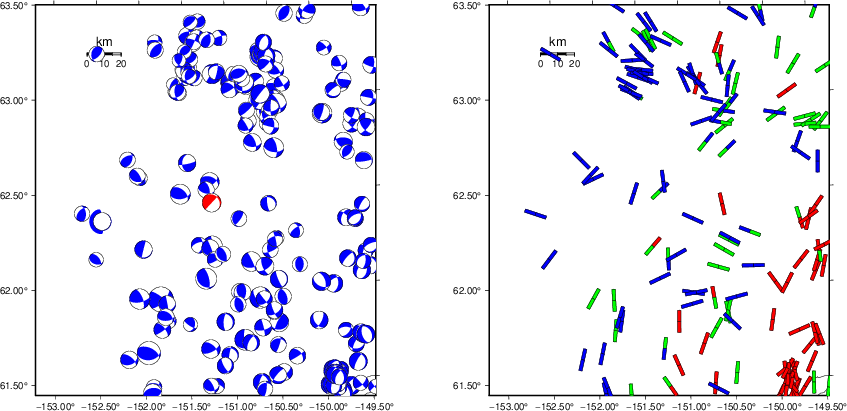Location
Location ANSS
The ANSS event ID is ak025a0u3q2q and the event page is at
https://earthquake.usgs.gov/earthquakes/eventpage/ak025a0u3q2q/executive.
2025/08/06 18:38:57 62.447 -151.216 84.4 4.6 Alaska
Focal Mechanism
USGS/SLU Moment Tensor Solution
ENS 2025/08/06 18:38:57.0 62.45 -151.22 84.4 4.6 Alaska
Stations used:
AK.BAE AK.BPAW AK.BRLK AK.CAST AK.DHY AK.FID AK.GHO AK.J19K
AK.J20K AK.KNK AK.KTH AK.L19K AK.L22K AK.M20K AK.MCK AK.MLY
AK.PAX AK.PPLA AK.PWL AK.RC01 AK.RND AK.SAW AK.SCM AK.SKN
AK.SLK AK.SSN AK.WAT6 AT.PMR AT.TTA AV.RED AV.SPCL AV.STLK
Filtering commands used:
cut o DIST/3.5 -40 o DIST/3.5 +50
rtr
taper w 0.1
hp c 0.03 n 3
lp c 0.10 n 3
Best Fitting Double Couple
Mo = 1.23e+23 dyne-cm
Mw = 4.66
Z = 96 km
Plane Strike Dip Rake
NP1 45 90 70
NP2 315 20 180
Principal Axes:
Axis Value Plunge Azimuth
T 1.23e+23 42 296
N 0.00e+00 20 45
P -1.23e+23 42 154
Moment Tensor: (dyne-cm)
Component Value
Mxx -4.21e+22
Mxy -6.89e+15
Mxz 8.17e+22
Myy 4.21e+22
Myz -8.17e+22
Mzz -1.01e+16
--------------
---##########---------
-####################-------
#########################----#
##################################
############################---#####
###########################-------####
######## ###############----------####
######## T ##############------------###
######### ############--------------####
######################-----------------###
####################-------------------###
##################---------------------###
###############-----------------------##
##############------------------------##
###########------------ -----------#
########-------------- P ----------#
#####---------------- ---------#
#-----------------------------
----------------------------
----------------------
--------------
Global CMT Convention Moment Tensor:
R T P
-1.01e+16 8.17e+22 8.17e+22
8.17e+22 -4.21e+22 6.89e+15
8.17e+22 6.89e+15 4.21e+22
Details of the solution is found at
http://www.eas.slu.edu/eqc/eqc_mt/MECH.NA/20250806183857/index.html
|
Preferred Solution
The preferred solution from an analysis of the surface-wave spectral amplitude radiation pattern, waveform inversion or first motion observations is
STK = 45
DIP = 90
RAKE = 70
MW = 4.66
HS = 96.0
The NDK file is 20250806183857.ndk
The waveform inversion is preferred.
Magnitudes
Given the availability of digital waveforms for determination of the moment tensor, this section documents the added processing leading to mLg, if appropriate to the region, and ML by application of the respective IASPEI formulae. As a research study, the linear distance term of the IASPEI formula
for ML is adjusted to remove a linear distance trend in residuals to give a regionally defined ML. The defined ML uses horizontal component recordings, but the same procedure is applied to the vertical components since there may be some interest in vertical component ground motions. Residual plots versus distance may indicate interesting features of ground motion scaling in some distance ranges. A residual plot of the regionalized magnitude is given as a function of distance and azimuth, since data sets may transcend different wave propagation provinces.
ML Magnitude

Left: ML computed using the IASPEI formula for Horizontal components. Center: ML residuals computed using a modified IASPEI formula that accounts for path specific attenuation; the values used for the trimmed mean are indicated. The ML relation used for each figure is given at the bottom of each plot.
Right: Residuals from new relation as a function of distance and azimuth.

Left: ML computed using the IASPEI formula for Vertical components (research). Center: ML residuals computed using a modified IASPEI formula that accounts for path specific attenuation; the values used for the trimmed mean are indicated. The ML relation used for each figure is given at the bottom of each plot.
Right: Residuals from new relation as a function of distance and azimuth.
Context
The left panel of the next figure presents the focal mechanism for this earthquake (red) in the context of other nearby events (blue) in the SLU Moment Tensor Catalog. The right panel shows the inferred direction of maximum compressive stress and the type of faulting (green is strike-slip, red is normal, blue is thrust; oblique is shown by a combination of colors). Thus context plot is useful for assessing the appropriateness of the moment tensor of this event.
Waveform Inversion using wvfgrd96
The focal mechanism was determined using broadband seismic waveforms. The location of the event (star) and the
stations used for (red) the waveform inversion are shown in the next figure.
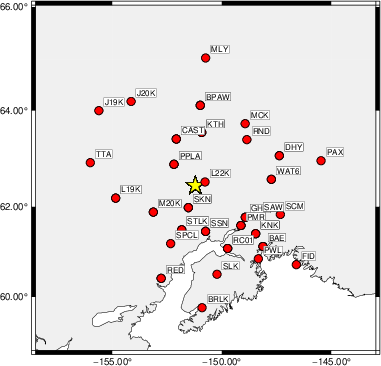
|
|
Location of broadband stations used for waveform inversion
|
The program wvfgrd96 was used with good traces observed at short distance to determine the focal mechanism, depth and seismic moment. This technique requires a high quality signal and well determined velocity model for the Green's functions. To the extent that these are the quality data, this type of mechanism should be preferred over the radiation pattern technique which requires the separate step of defining the pressure and tension quadrants and the correct strike.
The observed and predicted traces are filtered using the following gsac commands:
cut o DIST/3.5 -40 o DIST/3.5 +50
rtr
taper w 0.1
hp c 0.03 n 3
lp c 0.10 n 3
The results of this grid search are as follow:
DEPTH STK DIP RAKE MW FIT
WVFGRD96 2.0 0 50 10 3.67 0.1663
WVFGRD96 4.0 355 50 0 3.75 0.1927
WVFGRD96 6.0 355 60 -5 3.80 0.2152
WVFGRD96 8.0 355 55 0 3.88 0.2260
WVFGRD96 10.0 355 60 0 3.92 0.2308
WVFGRD96 12.0 355 60 5 3.95 0.2293
WVFGRD96 14.0 -5 60 10 3.98 0.2249
WVFGRD96 16.0 0 60 15 4.01 0.2175
WVFGRD96 18.0 0 65 25 4.03 0.2093
WVFGRD96 20.0 5 65 35 4.06 0.2067
WVFGRD96 22.0 5 65 35 4.09 0.2050
WVFGRD96 24.0 275 70 -20 4.12 0.2109
WVFGRD96 26.0 275 70 -20 4.14 0.2263
WVFGRD96 28.0 270 70 -20 4.17 0.2446
WVFGRD96 30.0 270 75 -25 4.19 0.2732
WVFGRD96 32.0 265 75 -25 4.22 0.3113
WVFGRD96 34.0 265 75 -30 4.24 0.3488
WVFGRD96 36.0 260 75 -30 4.26 0.3741
WVFGRD96 38.0 265 80 -30 4.29 0.3867
WVFGRD96 40.0 260 75 -40 4.37 0.4056
WVFGRD96 42.0 260 75 -40 4.39 0.4034
WVFGRD96 44.0 260 75 -40 4.41 0.4008
WVFGRD96 46.0 260 75 -40 4.42 0.4024
WVFGRD96 48.0 105 50 30 4.46 0.4080
WVFGRD96 50.0 105 50 30 4.47 0.4194
WVFGRD96 52.0 100 45 25 4.49 0.4296
WVFGRD96 54.0 230 80 -70 4.47 0.4393
WVFGRD96 56.0 230 80 -70 4.49 0.4564
WVFGRD96 58.0 230 85 -70 4.50 0.4746
WVFGRD96 60.0 225 85 -75 4.52 0.4945
WVFGRD96 62.0 50 90 70 4.53 0.5050
WVFGRD96 64.0 50 90 70 4.54 0.5235
WVFGRD96 66.0 45 90 75 4.56 0.5413
WVFGRD96 68.0 45 90 75 4.57 0.5582
WVFGRD96 70.0 45 90 75 4.58 0.5739
WVFGRD96 72.0 225 90 -75 4.59 0.5864
WVFGRD96 74.0 45 90 75 4.60 0.5992
WVFGRD96 76.0 45 90 75 4.61 0.6082
WVFGRD96 78.0 45 90 75 4.61 0.6175
WVFGRD96 80.0 225 90 -75 4.62 0.6234
WVFGRD96 82.0 45 90 75 4.63 0.6293
WVFGRD96 84.0 225 90 -75 4.63 0.6331
WVFGRD96 86.0 45 90 70 4.64 0.6360
WVFGRD96 88.0 225 90 -70 4.64 0.6411
WVFGRD96 90.0 225 90 -70 4.65 0.6436
WVFGRD96 92.0 225 90 -70 4.65 0.6464
WVFGRD96 94.0 45 90 70 4.66 0.6480
WVFGRD96 96.0 45 90 70 4.66 0.6486
WVFGRD96 98.0 225 90 -70 4.66 0.6480
WVFGRD96 100.0 45 90 70 4.67 0.6465
WVFGRD96 102.0 45 90 70 4.67 0.6432
WVFGRD96 104.0 45 90 70 4.67 0.6384
WVFGRD96 106.0 225 90 -70 4.67 0.6341
WVFGRD96 108.0 225 90 -70 4.67 0.6273
WVFGRD96 110.0 225 90 -70 4.67 0.6213
WVFGRD96 112.0 225 90 -70 4.67 0.6139
WVFGRD96 114.0 45 90 70 4.67 0.6055
WVFGRD96 116.0 45 90 70 4.67 0.5965
WVFGRD96 118.0 45 90 70 4.67 0.5874
WVFGRD96 120.0 50 85 70 4.66 0.5765
WVFGRD96 122.0 50 85 70 4.66 0.5682
WVFGRD96 124.0 50 85 70 4.66 0.5597
WVFGRD96 126.0 50 85 70 4.66 0.5496
WVFGRD96 128.0 50 85 70 4.66 0.5393
WVFGRD96 130.0 50 85 65 4.66 0.5301
WVFGRD96 132.0 225 90 -70 4.66 0.5120
WVFGRD96 134.0 50 85 65 4.66 0.5114
WVFGRD96 136.0 50 85 65 4.66 0.5023
WVFGRD96 138.0 50 85 65 4.65 0.4885
WVFGRD96 140.0 50 85 65 4.64 0.4447
WVFGRD96 142.0 55 80 60 4.61 0.3882
WVFGRD96 144.0 50 80 60 4.59 0.3343
WVFGRD96 146.0 55 75 55 4.56 0.2856
WVFGRD96 148.0 85 45 40 4.53 0.2543
The best solution is
WVFGRD96 96.0 45 90 70 4.66 0.6486
The mechanism corresponding to the best fit is
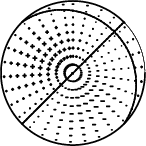
|
|
Figure 1. Waveform inversion focal mechanism
|
The best fit as a function of depth is given in the following figure:
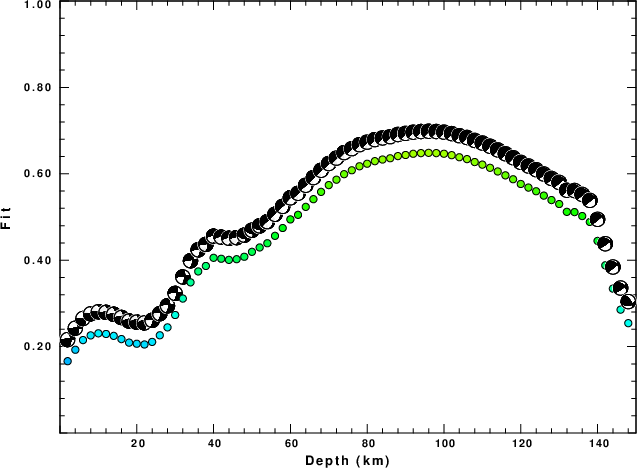
|
|
Figure 2. Depth sensitivity for waveform mechanism
|
The comparison of the observed and predicted waveforms is given in the next figure. The red traces are the observed and the blue are the predicted.
Each observed-predicted component is plotted to the same scale and peak amplitudes are indicated by the numbers to the left of each trace. A pair of numbers is given in black at the right of each predicted traces. The upper number it the time shift required for maximum correlation between the observed and predicted traces. This time shift is required because the synthetics are not computed at exactly the same distance as the observed, the velocity model used in the predictions may not be perfect and the epicentral parameters may be be off.
A positive time shift indicates that the prediction is too fast and should be delayed to match the observed trace (shift to the right in this figure). A negative value indicates that the prediction is too slow. The lower number gives the percentage of variance reduction to characterize the individual goodness of fit (100% indicates a perfect fit).
The bandpass filter used in the processing and for the display was
cut o DIST/3.5 -40 o DIST/3.5 +50
rtr
taper w 0.1
hp c 0.03 n 3
lp c 0.10 n 3

|
|
Figure 3. Waveform comparison for selected depth. Red: observed; Blue - predicted. The time shift with respect to the model prediction is indicated. The percent of fit is also indicated. The time scale is relative to the first trace sample.
|
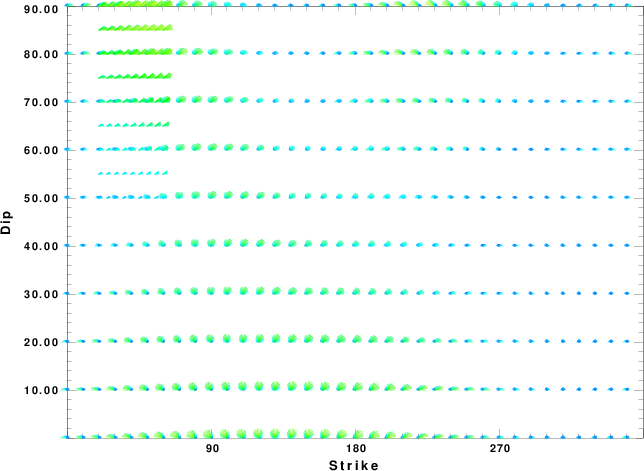
|
|
Focal mechanism sensitivity at the preferred depth. The red color indicates a very good fit to the waveforms.
Each solution is plotted as a vector at a given value of strike and dip with the angle of the vector representing the rake angle, measured, with respect to the upward vertical (N) in the figure.
|
A check on the assumed source location is possible by looking at the time shifts between the observed and predicted traces. The time shifts for waveform matching arise for several reasons:
- The origin time and epicentral distance are incorrect
- The velocity model used for the inversion is incorrect
- The velocity model used to define the P-arrival time is not the
same as the velocity model used for the waveform inversion
(assuming that the initial trace alignment is based on the
P arrival time)
Assuming only a mislocation, the time shifts are fit to a functional form:
Time_shift = A + B cos Azimuth + C Sin Azimuth
The time shifts for this inversion lead to the next figure:
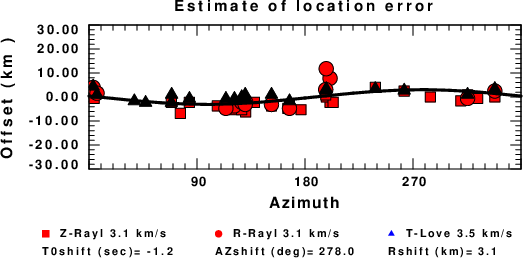
The derived shift in origin time and epicentral coordinates are given at the bottom of the figure.
Velocity Model
The WUS.model used for the waveform synthetic seismograms and for the surface wave eigenfunctions and dispersion is as follows
(The format is in the model96 format of Computer Programs in Seismology).
MODEL.01
Model after 8 iterations
ISOTROPIC
KGS
FLAT EARTH
1-D
CONSTANT VELOCITY
LINE08
LINE09
LINE10
LINE11
H(KM) VP(KM/S) VS(KM/S) RHO(GM/CC) QP QS ETAP ETAS FREFP FREFS
1.9000 3.4065 2.0089 2.2150 0.302E-02 0.679E-02 0.00 0.00 1.00 1.00
6.1000 5.5445 3.2953 2.6089 0.349E-02 0.784E-02 0.00 0.00 1.00 1.00
13.0000 6.2708 3.7396 2.7812 0.212E-02 0.476E-02 0.00 0.00 1.00 1.00
19.0000 6.4075 3.7680 2.8223 0.111E-02 0.249E-02 0.00 0.00 1.00 1.00
0.0000 7.9000 4.6200 3.2760 0.164E-10 0.370E-10 0.00 0.00 1.00 1.00
Last Changed Thu Aug 14 06:59:37 EDT 2025


